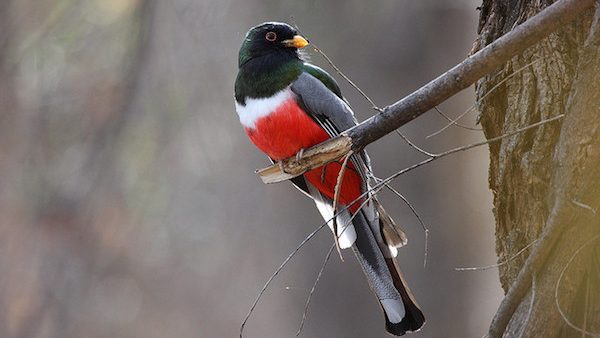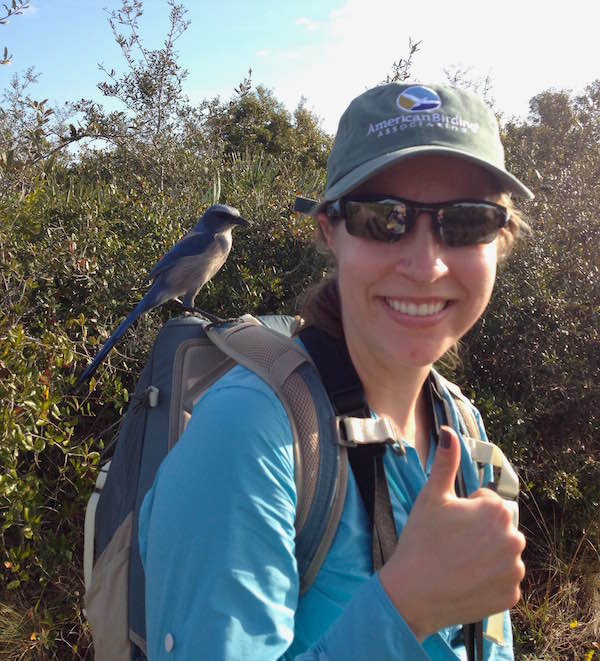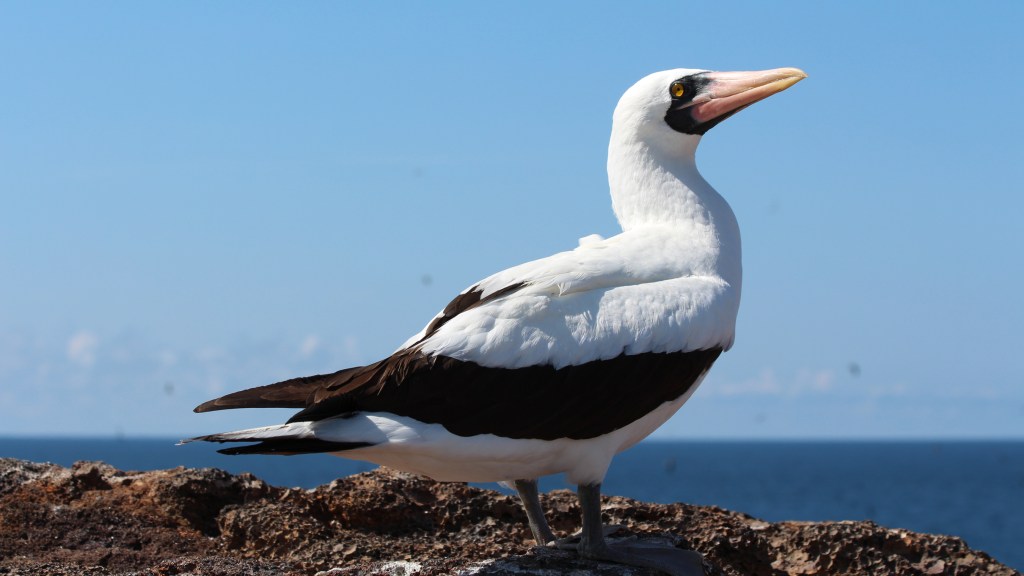It’s 5:00 a.m. and my headlamp is casting a narrow beam across the gray stones of the Josephine Saddle trail. Several miles into the canyon, binoculars at the ready, I listen for a barking krup, krup, krup and watch for a flash of ruby, emerald, and copper in the sycamores straddling the stream. But there’s no sign of the elegant trogon.
These gaudy, paunchy, jewel-colored birds rarely venture north of the Mexican border — except for a few secluded canyons in Arizona’s Santa Rita Mountains. Only the strange coincidences of ecology could bring me more than 2,000 miles across the country to stumble along a trail before dawn, attempting to bark like a Mexican bird in the hope of a reply.
But the bird just wasn’t there.
The only word running through my head isn’t fit for print. This was my one chance to find the trogon, and the stupid bird wasn’t there.
It’s my deep, secret, and possibly unfounded belief that most birders experience this occasional rage. (If they don’t, they’re either better people than I am or they’re lying.) The birding community even has a word for these epic birding fails: nemesis birds. The more times you fail to see a bird, the greater a nemesis it becomes.
Elegant trogon: 1, Justine Hausheer: 0.

The trogon wasn’t the only bird I missed that morning — gale-force gusts from the desert floor kept the trogons, warblers, and many other species silent during my 30-hour stay in Madera Canyon. Nor was that my first bad day in my admittedly short and almost entirely U.S.-based birding career.
Woodpecker finches in the Galapagos? I have no idea… trying to tell most Darwin’s finch species apart is an exercise in humiliation and despair.
Short-tailed hawks on Florida’s Lake Wales Ridge? After 6 hours tramping through the scrub my only souvenir was 60+ chigger bites.

Northern saw-whet and flammulated owls in the Colorado foothills? Unlike the birders, the birds decided not to traipse around in a 35-degree hailstorm.
But for every great bird I miss, another stunner just about falls into my lap when I least expect it.
A now-infamous snowy owl turned up on a parking garage sign in downtown Washington D.C. on a dreary January afternoon, a sighting about as likely as finding a bull moose munching roses on the capital lawn.
I nearly tripped over a pair of courting Nazca boobies on Isla Genovesa, and the male gently placed a twig at my feet. I won’t flatter myself — it was clearly meant for his lady friend — but I fell in love nonetheless.
On Merritt Island, a Florida scrub-jay perched on my head for several minutes, apparently convinced I had some snacks hidden under my hat. And my lifer limpkin nearly crashed into my car while I was parked near a power-plant-turned-wetland.

I’ll be the first to admit that the attempt and anticipation of chasing and landing a great bird is fun — I like listing and I like the wild goose chase it takes to find the whooping crane at the end of the rainbow. Er, marsh.
But the surprise birds are often the most memorable. And the nemesis birds are a reason to return — motivation to hike back up that trail one last time, or to stay up all night pathetically imitating an owl to a clump of sentient, silent pines.
Nature doesn’t always cooperate. And that’s okay.




I think my nemesis bird is the brown headed cowbird. Every spring he sits on my windsheild squawking at himself in our rearview mirrors. He leaves poop everywhere! P.S I’ve named him Lynyrd.
Thank you all for the wonderful comments! Justine left on a trip to do field reporting in Papua New Guinea very soon after this post went up. She will have a great time reading comments and responding when she gets back.
Free-loading Double-barred Finches – Once when staying in the spectacularly rugged town of Kununurra in the Kimberley region of northern Australia, I went out into a nearby national park in search of the delightful little Double-barred Finch. It was hot. Very hot! Like a trooper though I stuck with it and walked around the park but to no avail. After a few hours and near dehydration, I gave up lured by the thought of a swim in the caravan park pool back in town. When I arrived back, just before taking the cool plunge I noticed several Double-barred Finches sitting on the edge of the pool. I got my finch photo but not quite the one I wanted. A fiberglass pool edge kinda mocks the wildlife photography experience.
My top 3 nemesis birds (and how many times I’ve tried for them) are as follows:
1. Pileated Woodpecker (at least 15-20 tries.)
2. Least Flycatcher (Lost count – Probably seen it but never ID’d it)
3. Virginia’s Warbler (2 tries, but on one I missed the bird by under 10 seconds.)
I had the good fortune 10 yrs ago to view a pair of Elegant Trogans in Madera Canyon, but I live in AZ and had searched & hoped for some time. For years my nemesis was the Pileated Woodpecker; and fortunately good friends as well as a daughter’s family live in Maine. Still it took over five years of hunting & trailing until late last year on a fall hike through Wolf’s Neck Woods to spot & identify a spectacular Pileated. Worth the wait and effort!
Haha, this is great. Not a birder as such however if I have a nemesis it would have to be the orange wattled crow/South Island kokako AKA the greyghost. For quite a few years I unsuccessfully helped Rhys Buckingham in his quest to bring this bird back from extinction, and the search goes on. If you’re intrigued and want to learn more try this URL it’s a clunky site, I had to scroll down to find the information.
http://www.southislandkokako.org
For an online article that rounds it out well –
http://www.stuff.co.nz/dominion-post/capital-life/9723666/On-the-grey-ghosts-trail
There is also a facebook page but the link wouldn’t work for me.
9 days on Attu: a single Common Snipe and a single Pin-tailed Snipe.
ohhhouch.
Not a birder but was with Justine in the Galapagos. If I am ever to have an interest in birding, Justine would be the cause. She was enthusiastic, willing to share, and a joy to watch as we trooped around the Galapagos. So fun to see this article.
Elegant trogon relly? Come to Colima México we have those in Numbers waranted
Hi Justine – great topic for a blog post! We shared this with our Facebook community (Cornell Lab of Ornithology) and it sparked a ton of commentary along with a fair amount of commiseration about Elegant Trogons. In case you’re curious what people had to say, the post is here: https://www.facebook.com/cornellbirds/posts/1155140257864463 Keep up the great work. – Hugh
My nemesis birds are probably Black-backed Woodpecker and Spruce Grouse. This past winter a BB woodpecker turned up near me in Boston for several months, and I went 6 times to his allegedly often visited stakeout spot, but no luck.
The grouse became a nenesis bird during this year’s Acadia Birding Festival. I went on an all-day expensive van trip into the north which promised all the boreal species. We got gray jays, the only boreal species I’d seen before. The worst part was the grouse; their dust bathes and recent droppings were almost everywhere we stopped, but no grouse were apparent!
A friend and I have just returned from a trip to Hokkaido, Japan. The birding was as hot as the temperatures were cold! Displaying Red Crowned Cranes , Blakiston’s Fish Owl feeding, White-Tailed Sea Eagles diving for fish and the massive Steller’s Sea Eagles soaring right over our heads not to mention the numerous species of gulls and sea ducks, we almost forgot it was freezing outside, almost!
The day before we were to depart, we decided to take the southern coastal road and scan the rocky coastline along the way for one of our “most wanted” species, the Tufted Puffin. We knew mid-March was a bit early, but there had been reports of them in this area so even though the skies were filled with ominous slate grey clouds, we pressed southwards. The area is barren and desolate, made even more so with the snow starting to fall and the winds picking up. A few hours later, as we were driving in near blizzard conditions and doing our best to find our way with a Japanese GPS and a cheesy road map from the rental car company, (complete with animated Puffins along the coastline just to tempt us) we found our destination. “Welcome to Kiritappumisaki” (say that three times fast) signs welcomed us, and many buildings had car- toonish caricatures of Tufted Puffins with oversized bills adorning them. We were in the right place at last! We made our way out to the lighthouse and along the snow covered icy path, up and down hills some quarter mile or so out to the cape. We both stood out in the freezing cold, scanning the rocky cape, frequently stopping to wipe the snowflakes from our binoculars. My friend Tom yells “Penguins”! I knew of course exactly what he meant, he has seen the Puffins! Too excited to take the opportunity to correct him and chide him for the simple mistake, I im- mediately scanned in on two birds standing near a grassy overhang, their colorful markings visible even through the heavy snowfall. Naturally, we had left the cameras in the car so off I went jogging gingerly along the icy path back to the parking lot. What felt like an hour later but was probably closer to twenty minutes, out of breath and lungs searing, I made it back out to the cape to find Tom crouching behind a marker for some shelter from what now was a major snowstorm. Propping my lens up along the fence for stability, )I opted not to attempt to drag along the tripod) I took a few record shots and one last glance at the Puffins who stoically, hadn’t budged an inch in the storm.
After returning home, I sent an e-mail off to a colleague who is an authority on birds in Japan and told him of our journey to Kiritappumisaki to see the puffins. His reply the next day: Did you see the two decoys on the left under the grassy overhang?
By some miracle I saw an elegant trogon on my very first time looking at Patagonia Lake State Park in SE Arizona on March 1, 2013. Several hikers had spotted a male trogon about eye level in a bare tree about a half mile into the trail. I remember being in a bit of a shock finding it at about eye level in a forested area in a tree without leaves. It was not too concerned about our presence while we admired it and took photos for about 10 minutes. We spotted an elderly couple who had wandered off the trail and beckoned them quietly to come see the trogon. They were delighted but unfortunately the woman let out a squeal of joy and the bird flew away!! The couple told us they had been looking for a trogon for twenty years!! I feel like birding is serendipity and whatever you see is what you are meant to see. Walking on the trail that day we saw several people who apparently walked right past the trogon without seeing it.
I just wrote about my Nemesis Bird on my blog. Here’s the post:
Sixty years ago I saw my first scarlet tanager. I was ten.
I was sitting outside “in the country,” and I don’t know what made me look up, but there was the most beautiful bird I had ever seen. I called it a “real bird” because it was different than the plain brown birds I was accustomed to seeing. A “real bird” was the kind of bird I only saw in the Golden Guides my parents bought for me.
The scarlet tanager was in a tulip tree. The tulip tree was a “real tree” which I had also recently identified from my tree books. The days of pouring over those books were finally paying off.
I don’t know how long the gorgeous red bird graced me with his presence, but I do know that at the age of ten, it was one of the most joyous experiences of my life. It was the day my hobby was born. After that day, and for the next sixty years I searched for another scarlet tanager and another tulip tree. The tulip trees were easy. I saw many of them.
But the scarlet tanager quest was unfulfilled.
The sad part of the story is I admit, “I am the worst birder in the entire world.” On Audubon outings when I am on my best game, and I can see color, I can identify birds that are close up. On outings when I am on my regular game, I can confuse pigeons with bald eagles. I have learned to laugh at myself and have tried to educate myself. Even though I am “the worst birder,” I love being outdoors, being silent, and absorbing the sights and sounds of nature into my soul.
No scarlet tanager. How can that be? The bird books says he (the bright red male with black wings) is up there, but hard to find. Hard to find! I wonder how many other scarlet tanager searchers have been seeking the red phantom for sixty years? I am supposed to listen for him. Well, I mix up all my bird vocalizations, much as I try to work on improving my sightings.
I’m sure if I asked for help, from the many wonderful birding guides I’ve known over the years, I might have seen my tanager decades ago. But I didn’t. Mine was a private desire, lingering in my psyche for so many years—my tanager was becoming my holy grail.
(Of course, between my cataracts, retina surgery, touch of macular degeneration, hearing problems, perhaps I should be given a bird watching handicap…I don’t know what that is, but I know golfers get one) Oh well, I digress.
So the other morning I’m just sitting at my kitchen table and looking out to my deck where I have a bird bath (a plant saucer with two rocks in it for balance) and guess what! There, sitting on the edge of the plant saucer and leaning in to sip the water, is my scarlet tanager—the bird I have not seen in sixty years!
The last time I saw him, I was wearing plaid Bermuda shorts, a sleeveless shirt, and red or blue Keds sneaks. I probably went into the house and ate a tuna fish sandwich on white Wonder Bread, cut in squares by my mother. Maybe I cooed to my brother sleeping in his crib. If it was a Sunday, maybe my father was there reading the travel section of the paper and eating bread and butter, or maybe borscht.
That’s why, the other day, when I saw the scarlet tanager, I cried, hard.
It took me a long time to recover, and I was glad I was alone. I thought “No one will understand.”
But I do hope you will.
And, my scarlet tanager? I don’t know where he is now. But I am hoping he will drop in again.
Beautiful story, Ruth. Thank you so much for sharing, and may your Scarlet Tanager visit you again.